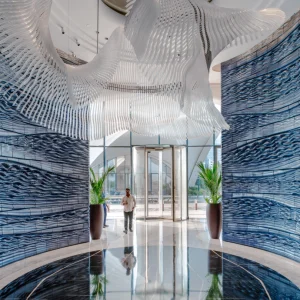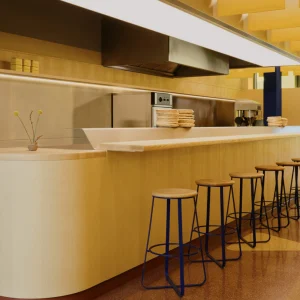Edited By Jill Enwistle
AT A CONFERENCE many years ago, the architect Piers Gough had the apparent temerity to suggest that there was absolutely no reason why you couldn’t have chandeliers in an office. It provoked the noisy exit of one offended delegate for whom it was a lateral thought too far. Such was the divide between the functional and the flamboyant that it had appeared unthinkable.
 Louis XIV, by Davide Groppi
Louis XIV, by Davide Groppi
But current luminaire design enjoys a more fluid approach, crossing boundaries and mixing craft with cutting-edge tech. The following luminaires are all sculptural, statement pieces – even a couple of limited editions – but reflect the many different directions currently pursued by lighting companies, from retro to romantic, and from organic to geometric.
Chandeliers might so far only have manifested in the communal, soft workspace areas of offices, or the mission control of the odd Silicon Valley giant, but you never know…
Luminora Light
Moooi

Designed by Cristina Celestino, Luminora is both simple and complex, a merger of craft (Murano glass) and contemporary techniques, a nod to past grandeur combined with precision optics. The faceted, transparent, polycarbonate tubes that form the two circular components feature a V-shaped diamond optical pattern. The LEDs create a 360° optical effect that shifts according to the viewer’s standpoint.
Luminora Light is available in two sizes: medium (45cm) and large (63cm), which allow more permutations for cluster installations. The medium version has a colour temperature of 2810K and output of 1760lm, while the larger is 2790K and 2790lm. Both have a high colour rendering (CRI 95). The top and bottom anodised aluminium brackets are champagne in colour. www.moooi.com
Aether
Lumina

Reminiscent of a monochromatic marble, Aether has a clear Japanese sensibility. Designed by Tokyo-based studio Aatismo, it is beautifully simple, at least in appearance. The diffuser is crafted using artisanal techniques in transparent borosilicate glass. Inside is a delicate handmade petal of Japanese organza. When illuminated, the natural transparency and diffusive qualities of the fabric change its shape and create nuanced effects from different angles.
The light source is a 21W LED, mounted in an aluminium frame, projecting a downward beam to illuminate the petal so that it appears to float. There are two colour temperature options: 2700K and 3000K (CRI 97).

The fitting (33cm at its widest points) is also dimmable, not only reducing light level but altering the aesthetic effect. www.lumina.it
LightMass^
Raw Edges

Launched at 2024 London Design Week, LightMass^ is a response to LEDs, say founders Yael Mer and Shay Alkalay, ‘a way to reintroduce physical form to lighting, creating sculptural structures’. The collection includes customisable pendants, floor lamps and table lamps.
A fair amount of tech lies behind the organic forms, designed to be minimal, lightweight and with low environmental impact.
Made from a durable, bio-based filament (renewable and recyclable), the intricate mesh is digitally designed in one continuous movement, drawing inspiration from the frameworks of Victorian greenhouses and the engineering of bridges.
The pieces are fabricated through FDM (fused deposition modelling) technology, producing flat sheets that are then transformed into their final three-dimensional forms. This ensures greater precision and minimises material waste. The openwork design not only adds to the aesthetic appeal but also reduces the material and weight required for production.
When not illuminated, the luminaires resemble delicate, suspended sculptures, but when switched on, the mesh surface casts intricate patterns of light and shadow. The flexibility of the design process allows for customisation in terms of size, pattern and colour. www.light-mass.com

Compass
Estiluz

The Compass collection, designed by Ester Pujol and Daniel Vila (Nahtrang Studio) for Spanish company Estiluz, includes pendant and wall versions. Minimal and geometric with a whiff of the 1950s (a muted suggestion of the Eames coatrack), the pendant is structured around adjustable arms that direct the light according to need. Using weight and tension (there are strings attached), the sphere above can be raised and lowered to widen and narrow the light distribution and position.
The pendant comes in single, two and four-arm versions (which can be combined for more complicated geometries). Colour temperatures are either 2700K or 3000K (CRI 90) and finishes are in black, beige and terracotta. www.estiluz.com
Volta (Memphis)
Estiluz

Firmly in the retro camp, the special version of Estiluz’s Volta lamp is a homage to Memphis, the company founded by design maverick Ettore Sotsass in 1981, and the man who, with playful forms and vibrant colours, cocked a snook at monochromatic good taste.
Estiluz produced a very limited edition of 55 numbered units to celebrate its 55th anniversary in 2024. Each lamp has a head illustrated by hand, ensuring that each has a distinctive character.
Made of metal, the pendant features a dimmable 2700K LED source (CRI 90), and an output of 725lm. www.estiluz.com

Candela
LZF

Madrid-based Candela Cort is actually known as a milliner (royalty, celebrities et al) but has turned her hand to lighting, her first collaboration outside the fashion world.
The collection of unique handmade pieces for LZF recall the compositions and colour balances of Russian painter Wassily Kandinsky.
Made of wood, the material LZF is known for, the collection is available in suspension and wall lamp versions. The coloured wood strips are seemingly chaotic but carefully positioned, with each piece numbered and signed by the artist. www.https://lzf-lamps.com

Louis XIV
Davide Groppi

If, like Davide Groppi, your design drive has been towards the increasingly reductive and achingly minimal there must come a juncture where you crack and produce something fabulously ornate. All that repressed desire for intricacy will out at some point. Or as Groppi puts it, Louis XIV is ‘a disobedient design’.
The natural brass branches are hand-shaped with a polished gold finish. The use of both direct and indirect dimmable warm light multiplies the effect of the crystals to create ‘the contemporary transposition of Versailles’. With an added bird for good measure.
The fitting, which without the cable measures 80cm, comes either with a remote or ceiling driver.
Alambicco
Artemide

Designed by Neil Poulton, Alambicco is yet another example of hi-tech softened by artisan technique. And yet another reference to the traditional brass-and-glass days in its ornate diffuser.
A modular pendant fixture that can be suspended horizontally or vertically (two lengths, 1,510mm and 1,010mm) depending on the version, it features blown glass, playing with transparencies and textures to control and diffuse light. Each piece is unique.
The centrally extruded aluminium structure supports LED circuits on the four opposing faces and is the technological core around which the various layers develop.
The first layer is a knurled glass cylinder, designed to refract the view of the technological components without completely hiding them, cutting out any potential glare. On this there are diffusers with rounded geometries, always transparent but textured by a process inspired by the traditional Venetian ‘balloton’ technique (whereby a diamond pattern is formed by blowing the glass into bronze moulds).
The various components that make up the diffuser refract light according to the varying thicknesses of the glass, breaking down and transforming the image of the technical gubbins in the core into a reflection of geometries and colours. These reflections blend with the chromatic hues of the surrounding environment. www.artemide.com
Funivia Stellar Nebula
Artemide

Two collections come together with a Stellar Nebula diffuser now available for the Funivia system.
Designed by BIG, Stellar Nebula is a family of lamps based on artisanal glass blowing combined with innovative physical vapour deposition (PVD) finishing techniques. The initial shapes of the diffusers are achieved through glass blowing and then freely shaped by master glassmakers to always create unique pieces. The result has the iridescence of a bubble.

Funivia is a highly versatile, horizontal and vertical ‘rope’ or cable system (with a sassy red option), which is both load bearing and power conduit. It is designed to ‘break out of the rigidity of fixed modules’, offering endless permutations and lighting possibilities – linear pendants, spots, decorative pendants, accent modules and more, all with multiple options. www.artemide.com






